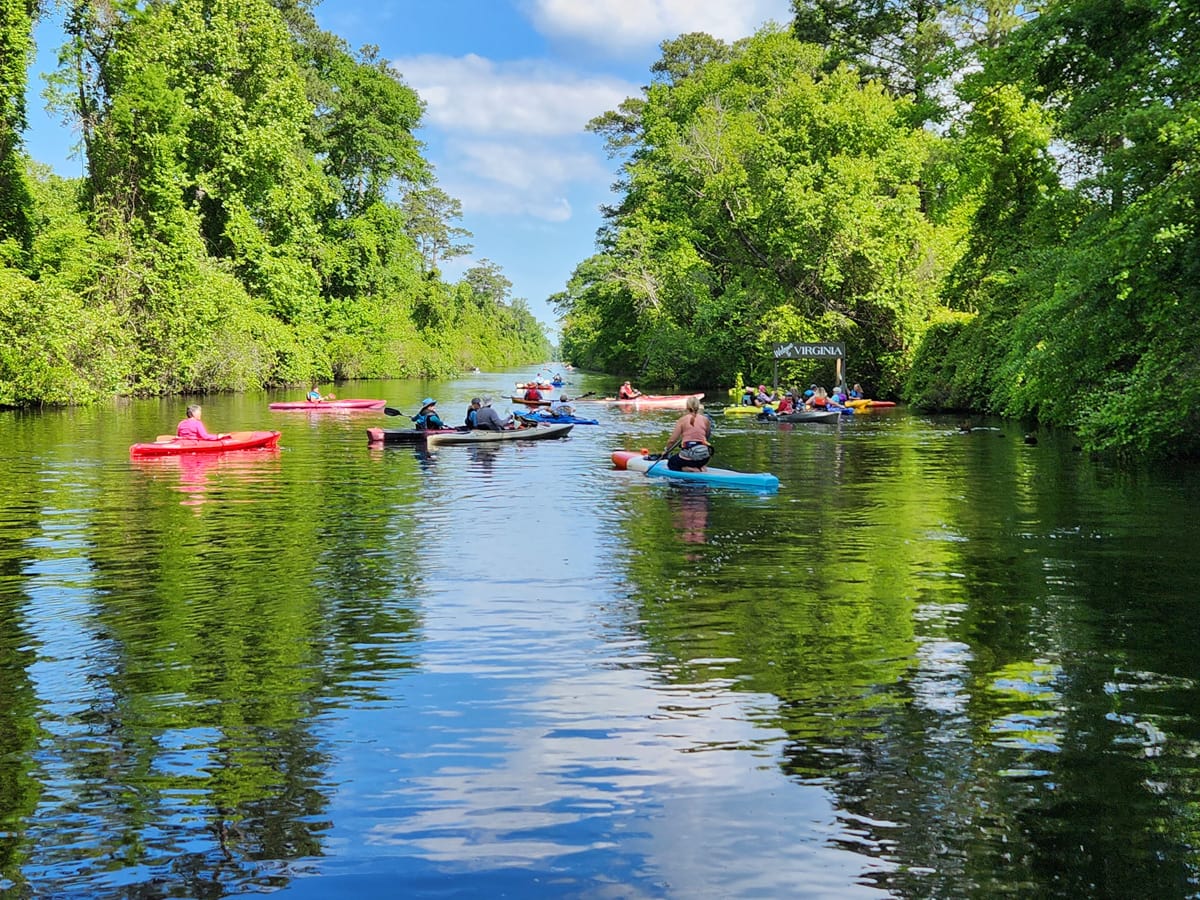
Go World Travel is reader-supported and may earn a commission from purchases made through links in this piece.
Time stands still as the mile markers go by
Tall, leafy trees shade me from the late morning sun, showing only a thin strip of vivid blue sky directly overhead. The water below my paddle board has an onyx-like shine as I effortlessly glide atop the Dismal Swamp Canal Trail in eastern North Carolina.
I’m paddling with almost 400 other people in multi-colored kayaks, canoes and paddle boards (and a handful of sculling rowboats). The speedsters racing the clock have already passed, while the more leisurely ones are still behind, giving me a small section of the lily pad-lined canal all to myself.
I pull up Radio Margaritaville on my smartphone. As the melody from Son of a Son of a Sailor floats in the air, I realize this might be the most relaxed I’ve ever been while doing strenuous exercise.
I’m participating in the 18th annual Paddle to the Border. It’s an event that draws over 350 paddlers of all ages and from all parts of the country to North Carolina’s Dismal Swamp State Park every May. It’s a leisurely event where time stands still as the mile markers go by. In its second running since pandemic breaks in 2020–2021, Sarah Hill, the park’s Welcome Center director, told me the 2023 event sold out in 72 hours.
Read More: Top 5 Spots for Stargazing in North Carolina
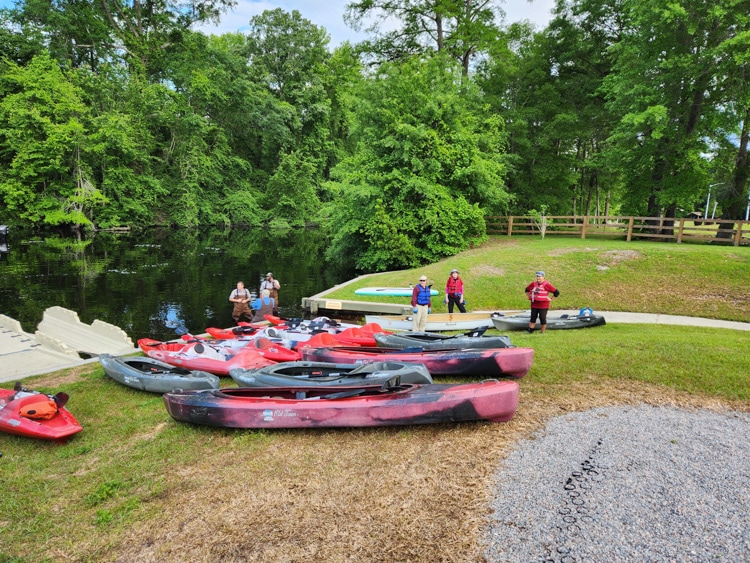
Ready, Set, Paddle
“I realize you had another event you could have participated in today,” said Head Ranger Adam Carver as he greeted paddlers surrounding the kayak ramp. “I’m so glad you chose to come here instead of the king’s coronation.” Comparing the Paddle to the Border to the coronation of King Charles III drew hardy laughter from the crowd as people finished the last of their breakfast bars and coffee before preparing their crafts for launch.
Best Tips & Tools to Plan Your Trip
Paddle to the Border covers seven miles of the 22-mile-long Dismal Swamp Canal, starting at the state park’s visitor center about 25 minutes north of Elizabeth City. The park and canal connect to the Great Dismal Swamp National Wildlife Refuge at the Virginia state line south of the town of Chesapeake.
This huge event is no small undertaking for the state park’s staff. Before he greeted the crowd, I asked Ranger Carver what the most difficult part of putting together an event with 400 people was.
“Nothing is difficult; it just takes time.” As I approach a group of paddlers taking selfies under the sign marking the state line, I realize that statement could apply to paddling the canal itself.
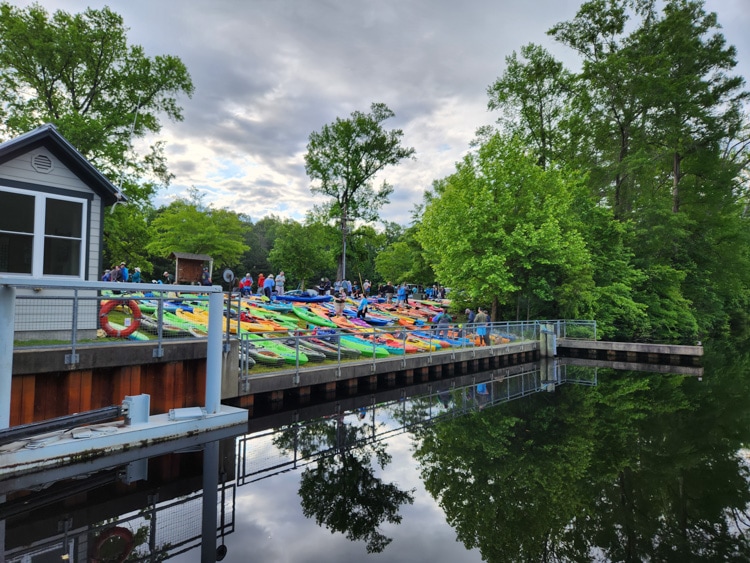
Part of American History
The canal I’m on has a long history that is intimately intertwined with the early development of the United States and was once a vital transportation artery of the eastern seaboard. George Washington himself recommended the digging of a canal through the marshy area to make transporting goods and people between north and south easier.
Using slave labor from nearby plantations, it took 12 years to dig the six-foot-deep canal in the swamp’s treacherous conditions, including oppressive heat and humidity and biting insects and animals, before the canal opened in 1805. In a fitting historical twist, the canal later became a gateway to freedom for escaped slaves as part of the Underground Railroad. By 1920, other, faster modes of transportation had made the canal obsolete, so the federal government took it over.
While no longer used to move goods, the canal is an important waterway for recreational boaters to get from Chesapeake Bay in Virginia to Albemarle Sound in North Carolina without having to navigate the unpredictable Atlantic Ocean and is still a part of the 3,000-mile Atlantic Intracoastal Waterway to the Gulf of Mexico. Because the US government still considers the canal a vital transportation portal, there is no overnight camping allowed in the state park or national refuge.
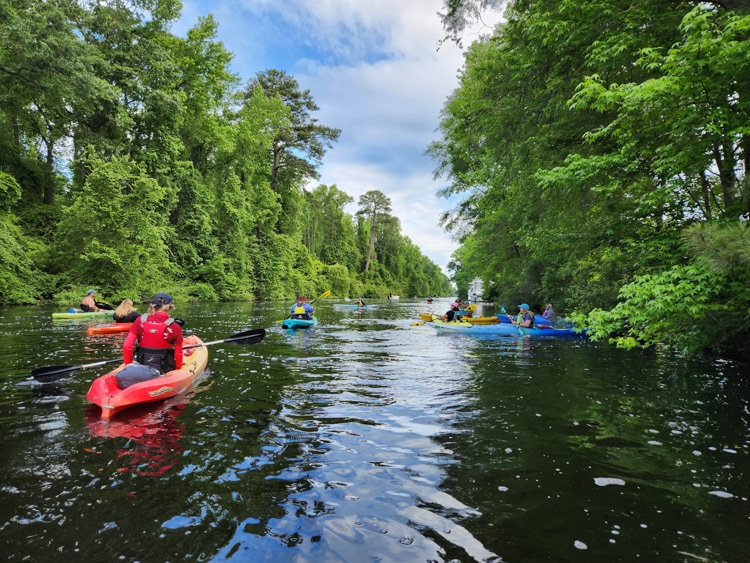
Dismal Swamp Canal Wildlife Refuge
While the colonists called it ‘dismal,’ the area was once home to Native Americans. Today it is part of the Great Dismal Swamp National Wildlife Refuge, home to over 200 species of birds and has North Carolina’s largest bear population along with bobcats, otters, and weasels.
According to the Welcome Center, the canal’s tea-tinted water is exceptionally pure and even healthy to drink. Tannic acids from the cypress, juniper, and gum trees growing alongside give the water its color, prevent the growth of bacteria, and, in the era before refrigeration, was highly prized by sailing ships that would barrel the canal’s water before long journeys.
Read More: 5 Things You Can Learn by Traveling in the South
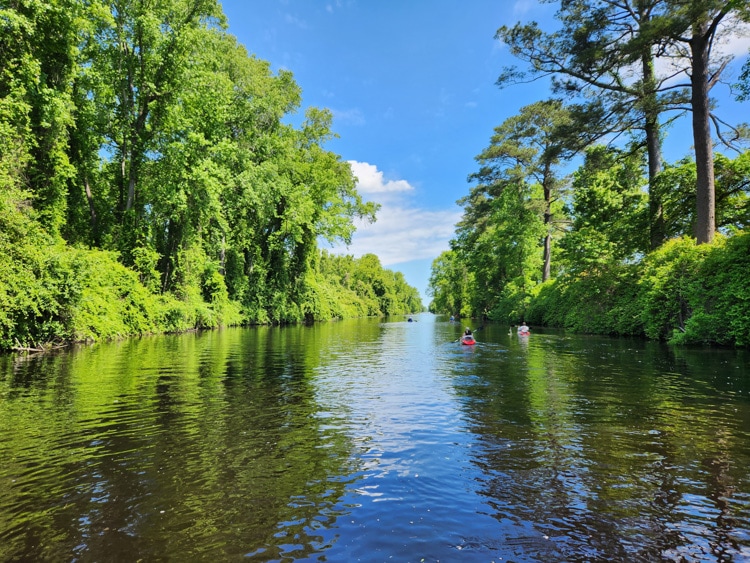
Paddling Through Nature
Paddle to the Border begins at the canal bridge by the Welcome Center in South Mills, NC, and ends at the Ballahack Road Boat Ramp in Chesapeake, VA. Besides breakfast snacks and coffee before, a BBQ lunch is provided to participants at the boat ramp’s picnic area afterward.
Due to limited parking, Hill says the event is capped at just under 400 participants. That means to enter the event, you must secure a pass the day tickets go on sale, usually the first Friday after New Year’s Day. In 2023, the fee was $55 per person, and you can rent equipment from the visitor’s center, but their rentals quickly sell out along with many of the other outdoor outfitters in Camden County and nearby Elizabeth City, so it’s best to bring your own gear. The fee includes breakfast snacks before and a BBQ lunch after.
Fortunately, you don’t have to participate in Paddle to the Border to enjoy the canal’s beauty. Those with their own kayaks, canoes, and SUP boards can enjoy the canal anytime and can even cover the entire 22 miles if they have the time and inclination.
Kayak and canoe rentals are available at the Welcome Center on the North Carolina side or through Chesapeake Parks, Recreation, and Tourism in Virginia. Experienced paddlers with thorough planning can put in at Elizabeth City for a more adventurous experience. However, for those who get the opportunity, Paddle to the Border is special.
As Carver says, “The best thing about it is seeing so many people enjoy the park.” As I admire the colorful crafts around me, including some with dogs as co-pilots, I have to agree.
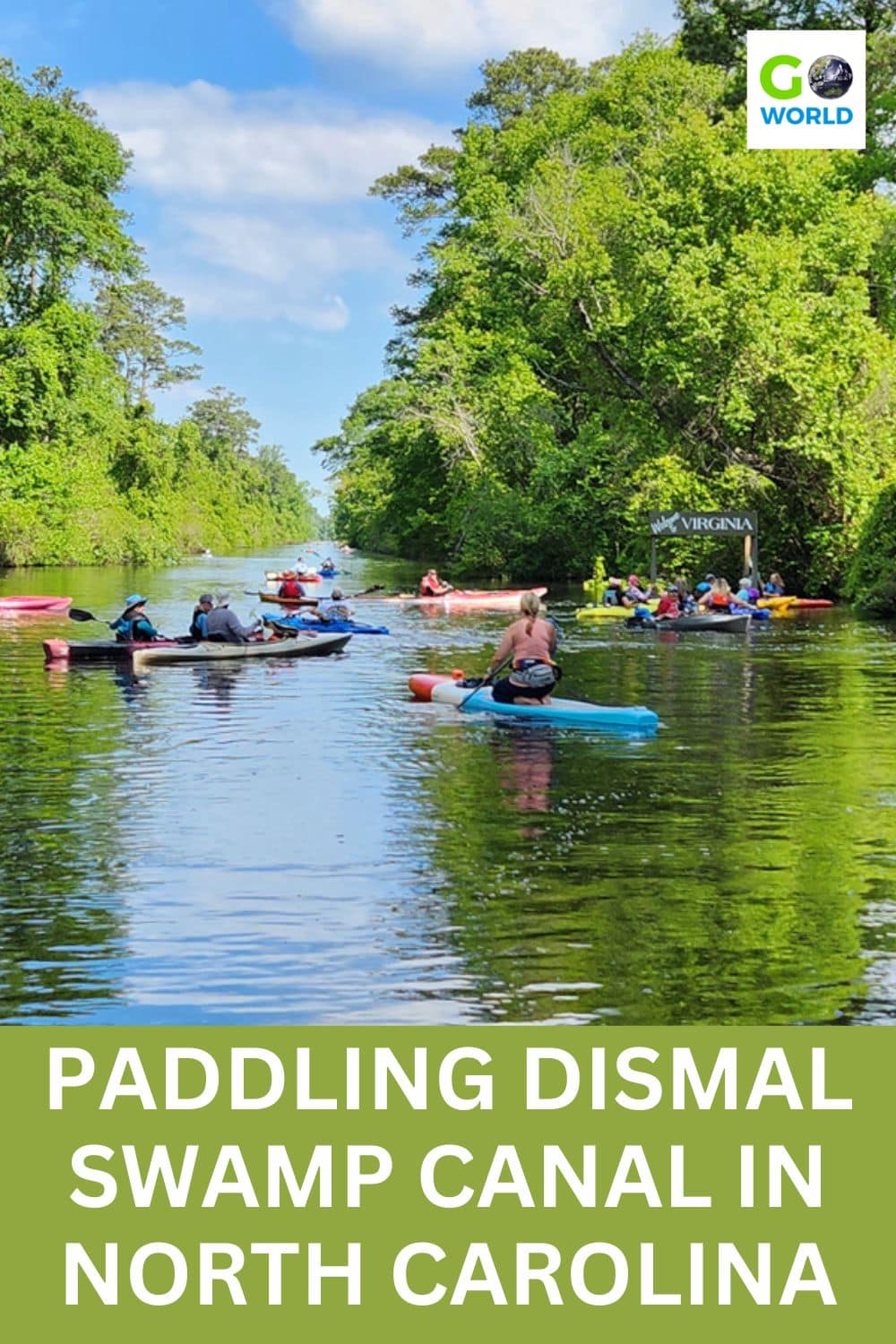
If You Go:
Author Bio: A member of the North American Travel Journalists’ Association, Carrie Dow is an award-winning travel writer based in Charlotte, North Carolina, and has written for a variety of publications, including Interval World, Artisan Spirit, Our State, and 5280. She is also the founder of What’s Pawsitive, a website covering animal welfare organizations and animal-based travel around the world.
Read More:
- Together at Sea: A Mediterranean Family Adventure - April 27, 2024
- Travel Guide to Colorado - April 26, 2024
- Travel Guide to Croatia - April 26, 2024

